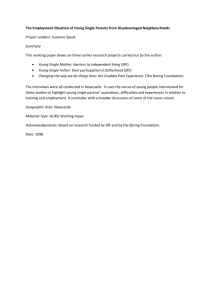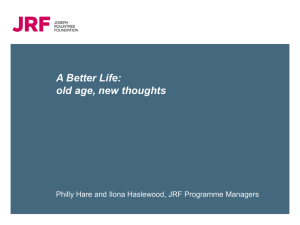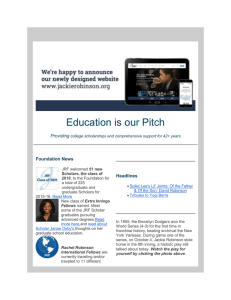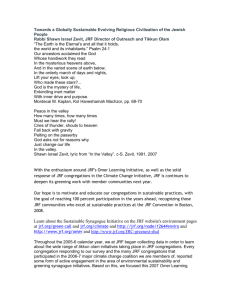dynamics_of_growth - Jewish Reconstructionist Community
advertisement
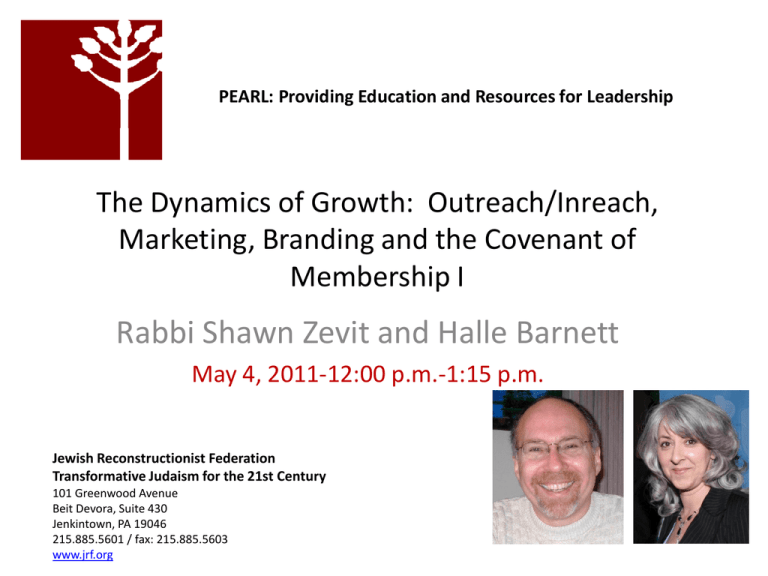
PEARL: Providing Education and Resources for Leadership The Dynamics of Growth: Outreach/Inreach, Marketing, Branding and the Covenant of Membership I Rabbi Shawn Zevit and Halle Barnett May 4, 2011-12:00 p.m.-1:15 p.m. Jewish Reconstructionist Federation Transformative Judaism for the 21st Century 101 Greenwood Avenue Beit Devora, Suite 430 Jenkintown, PA 19046 215.885.5601 / fax: 215.885.5603 www.jrf.org Kehillah Builders: Outreach (and in-reach) "Your entire community must be a membership committee of the whole" -- Rabbi Arnie Rachlis http://63.115.67.94/cong/res-kehillah-builders-main.htm "Being a Reconstructionist Congregation or Havurah means taking the building of sacred community to heart. Our purpose is to reach in and reach out - that is, to extend ourselves inwardly to our existing community, and also to reach out to the unaffiliated and the searching and offer them ways into our community. It means conscious efforts to grow, strengthen, and deepen the love for our community, the Jewish people and the world at large." - Adapted by Rabbi Shawn Zevit from the Inreach/Outreach committee of Reconstructionist Congregation Beth Emeth, New York Maimonides, Mishneh Torah, Gifts to the Poor 9:12 One who settles in a community for thirty days becomes obligated to contribute to the charity fund together with the other members of the community. One who settles there for three months becomes obligated to contribute to the soup kitchen. One who settles there for six months becomes obligated to contribute clothing with which the poor of the community can cover themselves. One who settles there for nine months becomes obligated to contribute to the burial fund for burying the community’s poor and providing for all of their needs of burial. Commentary for Parshat Zachor – Iturie Torah (a collection of Chassidic exegeses) Remember what Amalek did to you on your journey after you left Mitzrayim. How he surprised you on the march, and cut down all the weak ones who were behind. When you were famished and weary and were not God fearing. Therefore, when Adonai your God grants you safety from all your enemies around you; in the land that your God is giving you as a hereditary portion. You shall blot out the memory of Amalek from under the Heaven. Do not forget! –Deuteronomy 25:17-19 Had the children of Israel not forgotten about the slower ones in back but instead, brought them closer under the protecting wings of God’s Presence, binding the slower to all of Israel, the Amalekites would not have succeeded in their attack. But because you allowed the slower ones to be aharekha (meaning both “behind you” and “other”), that you separated them off from you and made them “other”, and you forgot about your brothers and sisters, Amalek could viciously attack them. Therefore, the Torah tells us to remember Amalek, so that we never forget to bring our brothers and sisters who need special attention into our midst. Cary Oshins, Past-President of Am Haskalah, Allentown, PA “What does it mean to join Am Haskalah? Member of what? As I see it, we are both a community and a congregation. A community is a network of relationships. You join it by taking part. The more you take part, the more you will build those relationships, the more connected you will feel, and the more our community will grow. “While the community is an informal network, the congregation is a formal organization. We have bylaws, officers, committees, employees, income and expenses. To be a member you have to fill out a form and pay your dues. The congregation provides the platform, the structure, in today's parlance, the hardware. The community is the software, the spirit and the real soul. I believe that if you are going to be a member of this community, you have a responsibility at some point to joining the congregation. And if you are a member of the congregation, please be a part of this community.” Growing Sacred Community Community building and membership growth is not exactly akin to marketing a product and increasing sales. Genuine, dynamic changes can lead to positive growth and increased participation and commitment. AND (not “but”), there is a third “pillar” on which congregational growth stands. In addition to internal (sometimes administrative) practices and external marketing efforts, there is the all-important aspect of relationship. Ultimately, it is not about the specific programming or the executive functioning of the office or the pizzazz of the public relations, as vital as they are. These are secondary and instrumental to the primary purpose of fostering caring relationships that address people in their wholeness and support them in their growth as Jews and human beings. Rather than a “cafeteria” to which we invite folks to “buy” a particular product or service, it is a community to which we invite them. Rabbi Steven Carr Reuben, of JRF affiliate Kehillat Israel , Pacific Palisades, CA, has a motto on his wall that says, “Caring for people is our only business.” More than any other “enterprise,” synagogue communities rise and fall on the strengths and weaknesses of personal relationships. He writes, “The number one reason why most people end their membership in synagogue life is they simply don’t feel connected, or believe that anyone would really care very much if they left.” The same is true for joining; people want to be connected and cared about. Our communities ought to be models of such behavior. Hitpatchut (Growth, Development) Inreach and Outreach, Rabbi Shawn Zevit • Far too often there is a tendency to equate growth only with quantitative increases in membership. A proactive and consciously framed in/outreach campaign recognizes the way this work invigorates every aspect of a community. • What we are trying to develop is a workable system where the process of reaching in and reaching out is attuned to our purpose and mission in a way that reflects our values and inspires deepened Jewish living and responsible membership in our global community. • What are the demographic and structural considerations that need to be in place to create a welcoming community? Are there boundaries to inclusivity? What are the Jewish values and texts that can inform our study and practice in this area? What educational programs could support this cultural environment? Why Do Outreach and Marketing? http://63.115.67.94/cong/res-kb-outreach-inreach.html Secularization (attitudes, values, behavior motivated by non-relig values & institutions) Dissolution of community Assimilation (social / cultural pressure,messages) Changing demographics (today’s Jewish family / community are different) Competition from other cultural /spiritual activities Rising expenses of congregations Scandals in religion (are we losing confidence in religion, leaders?) A la carte membership (picking and choosing experiences) Privatization of belief (trends toward anti-institutional, private practices) Hidden treasures (e.g., what is the Reconstructionist approach?) Making contribution to evolution of Jewish spiritual, religious peoplehood and the global community http://jrf.org/showres&rid=184 Inreach Values Inventory http://jrf.org/showres&rid=185 A. B. C. D. E. F. G. H. I. Message and Mission, Resources and Goals, Means and Ends Roles to Play – Multiple Entry Points Prospective and New-Member Programs Mentoring / Pairing Newsletters – More than “Upcoming Events” E-mail – Short and Sweet Personal Testimonials Social Media Coffee, a Phone Call, a Note Outreach A. “Members Beget Members” B. Advertising and Public Relations C. Community-Wide Offerings D. Targeting Niche Demographics E. “Friends of – ” F. Website G. Organizational Alliances, Coalitions, and Partnerships Text: Conscious Community “The whole premise of our group is the vast human potential… holiness is our key and our primary value; honors and comparisons serve no useful purpose. It is vitally important that we do not create, God forbid, any boundaries that separate us from Jews who are not members of our group. The whole point of our association is to love each other as much as possible. The techniques available to a group are qualitatively different than what an individual can hope to attain. It is important for us to be explicit and clear that our society accepts into its ranks only those individuals who share these concerns. If people know in their hearts that they are not similarly burdened with these concerns, we ask that they do not join our group. They will harm themselves and others. Their presence will serve as a distraction to the rest of the group, whose hearts and minds are sincerely focused on this work.” Rabbi Kalonymus Kalman Shapira, Conscious Community, Warsaw Ghetto, 1940’s More members? Or more engaged members? Stages of Membership: http://63.115.67.94/cong/res-kb-stages.html What if your most engaged members were your only members? What if ALL your members were your most engaged members? Are you attracting members who are “right” for your community? What happens when members decide you aren’t right for them? When the shidduch is a good one, can you point to why? The Shidduch YOU: “warm, welcoming, participatory, egalitarian and inclusive” Potential member: “Sounds good, but what’s in it for ME?” Marketing is a challenging notion for many of us, and the terrain keeps changing -- dwindling Jewish population, economic hardships, new media, little experience or people hours available. Good news: We do know TWO things very well … Our own experiences as members What it feels like to build and be in relationship with other members and the community The Member Experience What does your community mean to you? The Member Experience continued Our own experiences as members … Deeply held personal feelings – we all want to be valued, engaged, “known.” Person benefit and obvious value – the “what’s in it for me?” What it feels like to build and be in relationships with other members … An effective brand is focused on communicating those benefits in a way that will attract to your community others looking to have (and /or support) these same things, who are best suited to appreciate, participate in and further the experience. The Member Experience as an Outreach Tool So, based on what we know … Who is it that best understands your community-specific attractors and is / are best suited to do the “attracting?” Yes, its your engaged, excited members! Building a Culture of Commitment Do you have issues that you believe stand in the way of your effective outreach? Is “we need the money” a reason to grow? Good in-reach / Building a culture of commitment is less expensive, more sustainable, more lucrative, more genuine, and more joyful than using numerical growth as a fundraising tactic Imagine the possibilities if under-involved members became more active … Imagine the differences in their personal narratives when talking about their experiences as members! (e.g. Synaplex) Long Term Engaged Members are … Participating ( = behaving) Committed ( = believing) Connecting (= belonging) It goes beyond affiliating, and it's where congregations are most likely to stop. Member retention is about building sacred relationships. Growing and deepening in Relationship to Self, Other, World (= becoming) Getting Your Message Right Reconstructionist Movement branding / messaging coming: (Psst: Register for next week’s PEARL webinar!) You have your own stories to tell too Feeling hampered by your outreach tools (or lack thereof?) Before you worry about HOW you reach out, GET CLEAR on who you are Authentic communication healthy, long-term, reality-based relationships Getting Your Message Right continued YOUR BRAND IS: the collected experience of your organization in the mind of the public. How do we separate ourselves from the pack (and even make a good impression on people who are looking for something different than what we have to share?) (Hint: “Warm, welcoming, participatory, etc.” are table stakes…) Start by looking at your most engaged and supportive members: What do they have in common with each other, and with the core values and practices that serve your relationship with them most powerfully? Member Commonalities Meets Community’s Unique Value: Who are your members? How did you get them? What do they have in common -- socially, technologically, educationally, familially, practically, etc. ? What else defines them as a group, and what does that say about the community? How do you know? Is the kavannah behind your communication with them about exchanging info, or building relationships? Do your community’s values inform what you offer? What if that were front and center in your marketing ? Which of YOUR community’s unique values and/or traits drew you in and keep you engaged? Which will keep you top of mind with prospective members? What does your community bring to the table that no one else can claim? Getting Your Message Right continued HOW do you do “warm, welcoming, participatory, etc.?” Remember those deeply-held feelings / personal benefits? Have a community conversation to help hone these varied experiences/ benefits into adjectives that describe the specific experience of membership in YOUR community What do your most engaged and supportive members have in common with each other, and with the core values and practices that serve your relationship with them most powerfully? Your personal organizational values -- what you care about and why you’ve creative this particular community -- are your most potent brand and membership builders. Getting Your Message Right continued How do I use this information to grow - and engage - my membership? Frame the experience from the seeker’s point of view – as “benefits” rather than “features” Practice – with everyone – using those descriptive concepts to help people share the personal experiences so that the WAYS your community does “warm, welcoming etc.” can shine through as distinct from other congregations ‘ ways and thereby attract people looking for exactly what you have! Engaging your members in the creation of “potential” demonstrates you value their contribution on a deep level reminds them why they joined vests them in creating the future Getting Your Message Right continued YIELD from this valuable community conversation: Simple tool EVERY member can use to help increase your kehillah’s positive presence in the wider community Concise language reflecting your internal values that make inreach and outreach easier and more cohesive Mindful strategy for everyone involved – even those for whom you are not a good fit A concrete touchstone against which marketing, membership, fundraising, and other opportunities are evaluated and which will help you decide what we do to pursue those opportunities. (Ask: “Does this __________ jive with the truth we experience and want to demonstrate and share?”) Getting Your Message Right continued HOW do we work the big concept of Reconstructionism into the message? Not a well known thing – this is a pro and con! Don’t let the question freak you out! Sharing your experience of being a member of a Recon community answers the REAL question they are asking: “What’s it like to be a part of this experience – and what might I get out of it?” What about my brochure/website? Core values/ member experiences can be paralleled in your marketing tools E.g., Core Value = recognizing that life can be challenging, our community practices and support seek to help lighten the load for those on Jewish Journey Corresponding Member benefit = simplifying / ease MARKETING CHOICES THAT REFLECT THAT VALUE/BENEFIT Website = easy to navigate, soothing colors, point to resources, rather than tell the whole Megillah Brochure = large type, no script fonts, lots of white space Volunteer commitments should be similarly mindfully structured so no one experiences overload Further Resources Keruv Library Outreach, Newspaper and Magazine Ads and Press Releases http://jrf.org/keruv-library Brochures and Program Fliers http://jrf.org/keruv-library/search/165 JRF “Guide to Publicity.” http://63.115.67.94/cong/res-kb-guide-to-publicity.html and http://63.115.67.94/cong/res-kb-create-visibility.html. Webinar on using Facebook and Twitter http://jrf.org/keruv-library/search/225 JRF Resources Library http://jrf.org/resources-library&tid=2:13&show=#Membership http://jrf.org/resources-library&tid=2:12&show=#Marketing Creating a Welcoming Community Becoming a "Kehillah Mekabelet,” The Struggles of Transformation http://63.115.67.94/rt/transformation.html Ways to Welcome New Members http://www.jrf.org/showres&rid=188 and http://www.jrf.org/showres&rid=186 Further Resources, continued Previous PEARL sessions on Growth and Marketing: http://jrf.org/pearl/2009/dynamics-of-growth http://jrf.org/pearl/2008/growing-your-congregational-community http://jrf.org/pearl/2009/growing-the-soul-of-your-community http://jrf.org/pearl/2009/innovations-in-outreach-reaching-out-to-unaffiliated-andintermarried-jews http://jrf.org/pearl/2008/using-the-web-and-newsletters-for-successful-communitybuilding-and-engagement Other Great Resources! Frequently Asked Questions: http://jrf.org/resource-guide-faqs Audio Programs: http://jrf.org/heart-mind-spirit http://stores.jrfbookstore.org/-strse-Congregational-Resources/Categories.bok http://www.rrc.edu/ethics-center/publications/spiritual-community-power-restorehope-commitment-and-joy
